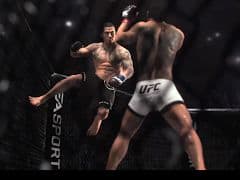You can trust VideoGamer. Our team of gaming experts spend hours testing and reviewing the latest games, to ensure you're reading the most comprehensive guide possible. Rest assured, all imagery and advice is unique and original. Check out how we test and review games here
Remember the first time you saw Fight Night Round 3 on Xbox 360? If you just responded ‘c’mon, grandad, I wasn’t even born when the last gen started,’ then fair enough. Everyone else, however, will remember. It’s impossible not to. Of all the launch window titles – and this was a line-up that included PGR 3 – it was the game that looked most next-gen. Whether it was via that demo, or buying the game with the machine, it was difficult not to be impressed: a near-photo-realistic orgy of violence of the sort you only really see in Hull, now in your living room. Smashing, in all senses of the word.
Watching UFC on Xbox One, I had a similar feeling of ‘sheeeit, that really, really looks like two guys giving it the old Superman vs Zod’. Whereas other games have to render entire worlds, GM for EA UFC Dean Richards told me, UFC – like Fight Night before it – puts all of its horsepower into making the two fighters in front of you – and their interactions – appear as realistically as possible.
From our brief glimpse, it appears EA has done exactly that. Previous MMA title (called EA, erm, MMA) looked good, but this is something else. One demo had a fighter rear-naked choking the life out of some poor fool, and thanks to EA’s new rendering tech it looked like I was watching it actually play out on ESPN.
This submission was chosen to show off the new, interlocking mechanics that result in the sort of ultra-realistic violence usually reserved for any game with the word Manhunt in the title. The first is the new full body deformation. EA is putting a lot of stock in this feature, as it demonstrates just how physical the sport is, as well as highlighting the heinous impact certain moves have on fighter’s bodies. It’s this impact, EA believes, that is at the heart of accurately recreating the UFC experience.
/https://oimg.videogamer.com/images/4fe6/ufc_03png.jpg)
“When you talk about full body defamation, you’re really talking about that body-to-body contact. there’s no sport that really [has that]…In the past, there was no physiology in the fighters, from the start of the fight to the end of the fight they all felt like they were fresh and ready to go. There was no vascular changes, no skin discolouration: that’s not true to the UFC.
“Now we’ll be able to [communicate these realities] through changes in blood flow, through vascularity; when you’re getting choked out you’ll be able to see the blood rush to the head, see veins pop.”
Quite. Seeing reigning lightweight champ Benson Henderson caught in this choke, eyes bulging, mouth gasping, blood rushing – all the fighters have had their gestures scanned, so that was his actual face – I was taken aback by how, well, real it looked. (I know that ‘real’ is an overused word, and somewhat relative. But, well, that was his head, for all intents and purposes. And it didn’t look happy.)
The deformation stuff is, according to Richards, just the first step in creating authentic fights. Linked to it is new damage and momentum systems. EA MMA was a great game, and the best simulation of the sport to date. Sometimes, however, it could feel like you were hitting your opponent with a wet ham rather than a solid fist.
“How do you sell that sense of force? It’s all about precision movement. In the past, guys would just slide around. How do you sell force or momentum when you’re sliding around and it just looks like you’re skating out there in the octagon.
“The way it is now, everything’s planted, engaged, ready to go bang, and you can actually sense that force.”
/https://oimg.videogamer.com/images/358a/ufc_02png.jpg)
In short, when you hit someone now, it actually feels like they are getting struck. Again, it ties into another system: damage modeling. Without sounding too much like a psychopath, there’s nothing better in Fight Night or EA MMA than cutting your opponent – aesthetically it gets both competitors riled up, and mechanically it means you’re one step closer to ending the fight.
According to Richards, however, it’s always been canned: something that’s going to chance in UFC.
“In the past, [damage] was linear. I would hit you a few times, you’d get the gash over the top of your head. I’d punch you a few more times, and more blood would come out and land in the exact same way. The same cut on you would be the same cut on me.
“In our game now we’ve got non-predictive, non-linear [damage], even differences in viscosity in blood, whether it splats or whether it’s an open cut.”
Submissions, too, have been altered – although to what extent was not made absolutely clear.
“In the past, you would get that submission and go straight to the end goal [lock it in straight away] and then go and button mash or [rotate the sticks]. It was a minigame that took you out of the experience.
“That’s not how it happens. It takes precision movement and position to get that control. There’s many things you have to do to finally get the armbar. That’s how we’re doing submission battles. It’s about getting into that position and establish control.”
This sounds good on paper – no-one wants to play a UFC Undisputed 3-style minigame, but there’s a slight worry that the battle for position might hinder the quick, clear nature of EA MMA’s sub system.
We’ll know for sure as the year unfolds, but as it stands EA’s UFC game looks very impressive. It may have been a small glimpse at what’s on offer, but graphically it was one of the best-looking games at E3. If it can marry those looks to systems that improve upon the already-excellent EA MMA, then this will be well worth picking up later next year.
EA Sports UFC
- Platform(s): PlayStation 3, PlayStation 4, Xbox 360, Xbox One
- Genre(s): Sport







